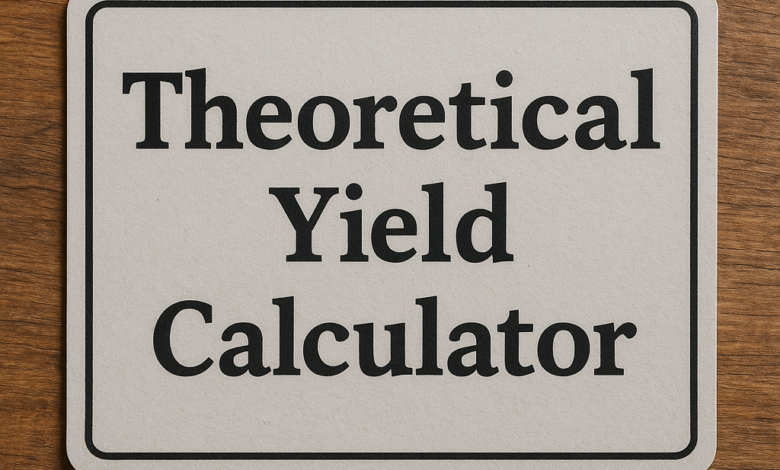Theoretical Yield Calculator: A Comprehensive Guide to Calculating Reaction Efficiency

Theoretical Yield Calculator: How much product should I expect? The answer lies in the theoretical yield, which is the maximum amount of product that can be generated from a given amount of reactants under ideal conditions.
Theoretical yield assumes a 100% efficient reaction, meaning no side reactions occur, no product is lost during purification, and all reactants fully convert into the desired product. In reality, most reactions fall short of this due to practical limitations, which is why chemists also calculate percent yield—the ratio of actual yield to theoretical yield. Understanding these concepts helps optimize reactions, reduce waste, and improve efficiency.
Theoretical Yield Formula: Breaking It Down
The theoretical yield is calculated using stoichiometry—the study of quantitative relationships in chemical reactions. The formula is:Theoretical Yield=Moles of Limiting Reagent×Stoichiometric Coefficient×Molar Mass of ProductTheoretical Yield=Moles of Limiting Reagent×Stoichiometric Coefficient×Molar Mass of Product
Key Components of the Formula
- Moles of Limiting Reagent – The reactant that runs out first, restricting the reaction’s progress.
- Stoichiometric Coefficient – The number before a compound in a balanced equation.
- Molar Mass of Product – The molecular weight of the desired product.
Why Is This Formula Important?

- Helps predict the maximum possible product.
- Identifies the limiting reagent to avoid excess reactant waste.
- Serves as a benchmark for reaction efficiency when compared to actual yield.
For example, if you react 5g of acetone with 2g of cyanide, the theoretical yield calculation ensures you know the exact expected output before running the experiment.
How to Calculate Theoretical Yield: Step-by-Step Guide
Calculating theoretical yield involves a systematic approach:
Step 1: Balance the Chemical Equation
Before any calculations, ensure the reaction is balanced. For example:Acetone+Cyanide→HydroxyacetonitrileAcetone+Cyanide→Hydroxyacetonitrile
Step 2: Determine the Limiting Reagent
- Convert reactant masses to moles.
- Compare mole ratios to identify which reactant limits the reaction.
Step 3: Use Stoichiometry to Find Product Moles
Multiply the moles of the limiting reagent by the product’s stoichiometric coefficient.
Step 4: Convert Moles to Grams
Multiply the product moles by its molar mass to get the theoretical yield in grams.
Example Calculation
If 8g of calcium carbonate reacts with 9g of acetic acid, the theoretical yield of acetone can be calculated step-by-step to ensure accuracy.
Percent Yield Calculator: Measuring Reaction Efficiency
While theoretical yield provides the ideal scenario, percent yield reveals real-world efficiency:Percent Yield=(Actual YieldTheoretical Yield)×100%Percent Yield=(Theoretical YieldActual Yield)×100%
Why Percent Yield Matters
- Low yields indicate side reactions, incomplete conversions, or purification losses.
- High yields suggest optimized reaction conditions.
For instance, if your theoretical yield is 6.54g but you only obtain 5.2g, your percent yield is ~79.5%, indicating room for improvement.
Dividend Yield Calculator vs. Chemical Yield: Clearing the Confusion

While yield is a common term in both chemistry and finance, their meanings differ:
| Chemical Yield | Dividend Yield |
|---|---|
| Measures product efficiency in reactions | Measures investment returns |
| Uses stoichiometry | Uses stock price and dividends |
| Expressed in grams or moles | Expressed as a percentage |
A dividend yield calculator helps investors assess profitability, whereas a theoretical yield calculator helps chemists optimize reactions.
Common Mistakes When Calculating Theoretical Yield
1. Ignoring the Limiting Reagent
Using excess reactants without identifying the limiting one leads to incorrect yield predictions.
2. Incorrect Stoichiometry
Unbalanced equations result in wrong mole ratios, skewing calculations.
3. Unit Mismatch
Mixing grams and moles without conversion leads to errors. Always ensure consistent units.
4. Overlooking Side Reactions
Impurities and side products reduce actual yield, but theoretical yield assumes perfect conditions.
Practical Applications of Theoretical Yield Calculations
1. Pharmaceutical Industry
Drug synthesis requires precise yield predictions to ensure cost-effective production.
2. Environmental Chemistry
Waste minimization in industrial processes relies on accurate yield estimations.
3. Academic Research
Students and researchers use theoretical yield to validate experimental results.
FAQs on Theoretical Yield Calculator
Q1: How do I find theoretical yield?
- Balance the reaction.
- Identify the limiting reagent.
- Use stoichiometry to determine product moles.
- Convert moles to grams using molar mass.
Q2: What’s the difference between theoretical and actual yield?
- Theoretical yield is the ideal maximum.
- Actual yield is what you obtain in the lab.
Q3: Can theoretical yield exceed actual yield?
No, actual yield is always ≤ theoretical yield due to practical losses.
Q4: How does a percent yield calculator help?
It quantifies reaction efficiency by comparing actual vs. theoretical yield.
Q5: What if my percent yield is over 100%?
This suggests impurities, measurement errors, or incomplete drying.
Conclusion
Mastering theoretical yield calculations is essential for chemists, students, and industry professionals. By understanding the relationship between limiting reagents, stoichiometry, and percent yield, you can optimize reactions, reduce waste, and achieve better results.





